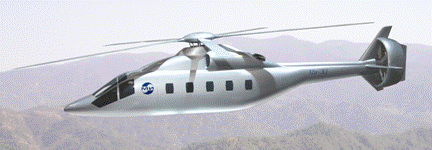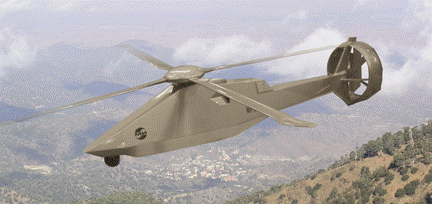Pusher propellers will be the level-flight propulsion configuration of choice for Russian helicopter manufacturers Mil and Kamov for a new breed of high-speed rotorcraft to fly in the 2015 timeframe.
This year, both the legacy Russian helicopter specialists revealed high-speed helicopter concepts, competing for the Rb15 billion ($635 million) government allocation for development of new rotorcraft technologies.
The funding has been promised by Oboronprom and Helicopter Holding, the two organisations forming the Kremlin-controlled structure in charge of the nation's helicopter industry.
The high-speed rotorcraft initiative amounts to 10% of the Rb150 billion two-decade programme to invigorate the Russian helicopter industry, with the aim of keeping Russia among the leaders in the global market for vertical take-off and landing air vehicles.
Strong foothold
The Kremlin is ready to provide half of the sum from the state treasury, chiefly from non-refundable allocations for technology development and production preparations.
The rest will be raised commercially through mass production. The government-sponsored development of indigenous machinery is at the heart of the Kremlin's new strategy that puts a premium on industry sectors where it has a strong foothold, including aerospace.
Spending on high-speed technologies is seen as a necessary ingredient in achieving profitable growth for the Russian rotorcraft industry.
The helicopter programme targets an increase in annual production from 120 units in 2007 to more than 300 in 2015. Helicopter Holding says it is on track for 165 helicopter deliveries this year and more than 200 in 2009. The rise in output is a positive sign that the integration of the national helicopter industry, launched in 2004, has been beneficial.
Oboronprom's strategy calls for a "turn from sales of helicopters to that of the helicopter's whole cycle, covering construction, sales, after-sales support and recycling".
To boost sales in the traditional markets, Oboronprom is opening "world standard" customer support centres in India, China and Latin America, as well as across the immense Russian territories.
It is forming a "strategic partnership" with AgustaWestland and talking to Eurocopter about "co-development" of new designs.
The strategy is intended to bring rapid expansion of manufacturing capacity and infrastructure. Oboronprom fears that without creating a new breed of best-selling helicopters in the next decade, Russia's rotorcraft industry may collapse because of its non-competitiveness in the global marketplace.
Immediate action will be investment in the Mi-8/17, the current milk cow for the Russian helicopter industry. First flown 47 years ago, the Mi-8 still retains some sales potential.
New technology insertions in the "next-generation" Mi-8M will increase its speed by 16kt (30km/h) to 140kt in cruise and 150kt in flat-out level flight, and range by 200km (108nm), to 900km on inner tanks and 1,200km with external stores. Officials say the incremental changes will enable the veteran to sell for 10-15 more years.
The much-delayed Mi-38 and Ka-62 projects have been boosted in view of deliveries scheduled for 2011, but the machines are seen as a temporary fix for Russia's international competition concerns. To support sales beyond 2015-20, officials say Russia needs a totally new breed of vertical take-off and landing machine.
While the Mi-8M, Mi-38 and Ka-62 are "bridging the gap", Mil and Kamov designers are working on new concepts in a competitive environment. Oboronprom is financing research programmes that will culminate in experimental prototypes taking flight.
"The main purpose of this effort is to ensure Russia will keep pace with the USA and Europe in technologies of high-speed rotorcraft," says Andrei Shibitov, head of Helicopter Holding. But the creation of a deliverable product is not on the agenda now, he adds.
 |
|---|
©Vladimir KarnozovMil's Mi-X1 is being developed for a cruise speed of 257kt and maximum speed of 280kt using an innovative main rotor with computer control |
Kamov has two concepts - the Ka-90 and Ka-92. Mil is challenging with the Mi-X1 and unpiloted MRVK. Although the vehicles fall into different classes, it is unlikely that all four will proceed beyond the experimental stage.
Based on the results of flight testing, a single superior concept is expected to be selected to serve as the base for the creation of production models. This approach should keep Kamov and Mil in a competitive environment, stimulating their design teams.
 |
|---|
©Vladimir KarnozovMil's unpiloted MRVK uses a rotor system similiar to that of the Mi-X1 |
Radical concept
The most radical concept is the Ka-90, described as a "high-speed vehicle of rotorcraft type". Kamov general designer Sergey Mikheyev says the Ka-90 has been a "long evolving" concept of "helicopter at take-off/landing, and airplane in cruise flight".
In essence, the Ka-90 is a "variable-geometry" air vehicle with two separate propulsion systems, one for cruise and one for take-off/landing.
Proposed in 1985, it was shelved after the collapse of the Soviet Union.
Now dusted off, it is back under work. A scale model revealed at the HeliRussia 2008 show in May provided evidence of the Ka-90 having a turbojet in the rear fuselage for high-speed level flight and retractable rotor for take-off and landing.
Presumably, the lift in cruise flight will be generated by a "wing", in this case a huge, specially shaped container above the fuselage to which the rotor blades are retracted after being folded. According to Mikheyev, the Ka-90 is intended to have a cruise speed of 378kt.
"The Ka-92 high-speed helicopter for long ranges is another vehicle on which we are going to assess various innovative design solutions," says Mikheyev. Although more recent, the Ka-92 is less radical, he says, "essentially a high-speed helicopter".
Kamov is developing the vehicle in the hope that it will proceed to production, filling a market niche.
"For exploration of Russia's northern regions, including oil fields, we need an effective transport system - one that would employ helicopters with higher speed and range," says Mikheyev. He points out that today's helicopters are "naturally" limited to a cruise speed of 162kt and a range of 700-800km.
But in some cases, a range of 1,200-1,400km is required, for instance when a helipad at destination temporarily closes down, perhaps because of weather conditions, forcing the crew to return to base without refuelling.
Another distinct market exists in remote territories with undeveloped aerodromes. Such areas are served by helicopters that maintain regular passenger and cargo services with flights lasting up to 3h.
The Ka-92 would be able to cut flight time substantially, making a return flight possible with no special infrastructure in place at the destination.
With a cabin for 30 passengers, the Ka-92 will have a range of 1,400km at 227-243kt cruising speed. Take-off weight will be about 15,000kg.
It will have two Klimov VK2500 engines, each generating 2,400hp at take-off and 2,700hp in emergency mode, or the more advanced VK3000 (TV7-117V), developing 2,800hp and 3,750hp, respectively.
The engines will drive the co-axial main rotor - the firm's speciality - and counter-rotating coaxial pusher propellers in the rear fuselage. The propellers will give the Ka-92 a speed boost in level flight and provide torque balancing.
New solutions
"For over 40 years, the helicopter makers of the world have been using essentially the same principles of aerodynamics and control system," says Mikheyev. "The time has come to look for new solutions to vertical take-off and landing aircraft, centring on improving the aerodynamic perfection of the helicopter as a flying vehicle."
Mil general designer Aleksei Samusenko agrees with Mikheyev, but prefers other ways of achieving the goal. The Mi-X1 and MRVK use similar rotor systems, with a main rotor and rear-mounted pusher propeller that gives a boost in cruise and adds torque stabilisation through thrust vectoring. The Mi-X1 is being developed for a cruise speed of 257kt and maximum speed of 280kt using an innovative main rotor design with computer control.
Mil is working on a system to suppress local stalls on the retreating blade. Like the Ka-92, Mil's design also has two VK2500s for power, but is lighter at 10,000kg normal and 12,000kg maximum take-off weight. The smaller cabin will accommodate 20-25 passengers or 3,500-4,000kg of cargo. Static ceiling will be 11,500ft and range up to 1,550km.
Samusenko says a lot of scientific research will be done in the project's early stages, including testing new systems on flying laboratories, before the Mi-X1 proceeds to its first flight "before 2014".
Source: Flight International
















